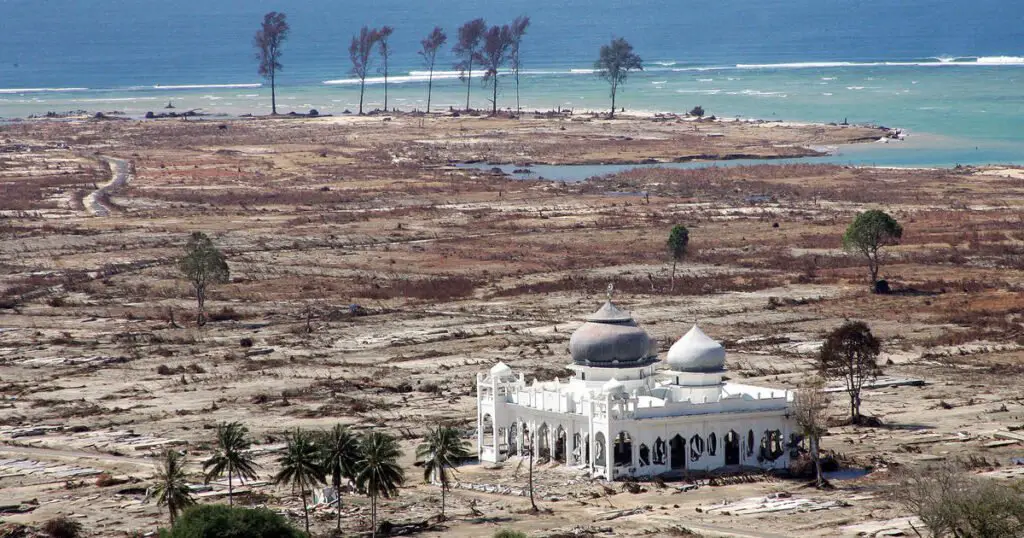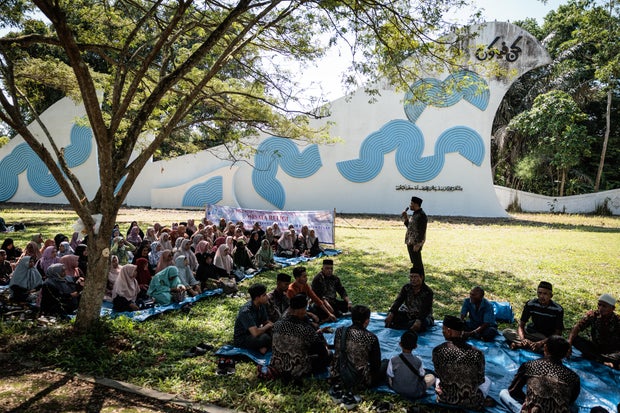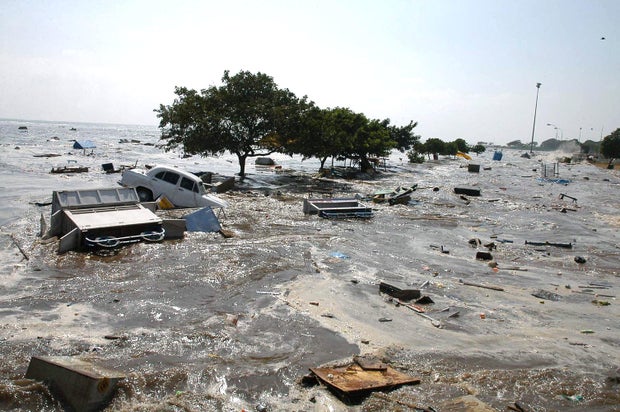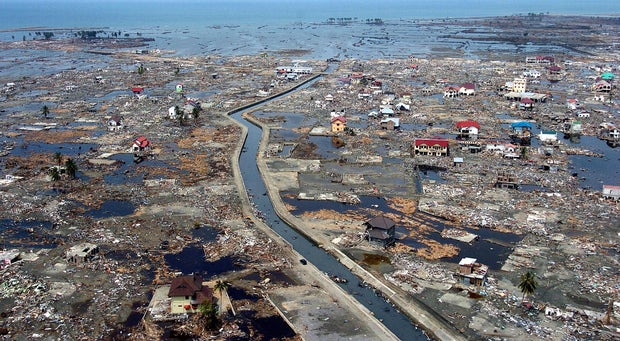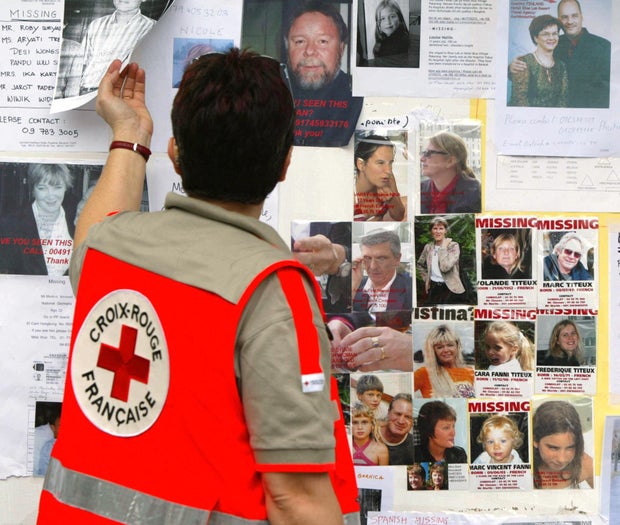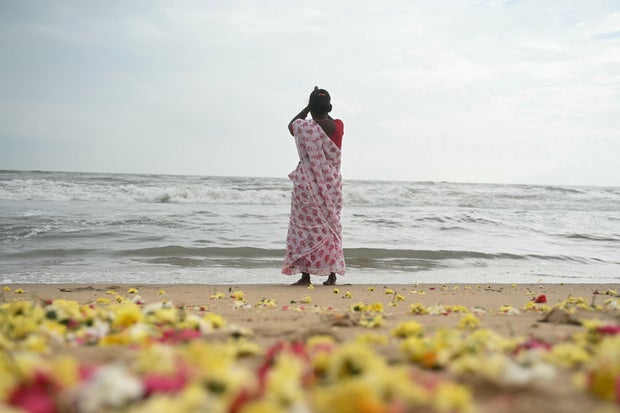On Thursday, people gathered for prayers and visited mass graves in Indonesia’s Aceh province to mark the 20th anniversary of the massacre Indian Ocean tsunami The region was hit by one of the worst natural disasters in modern history.
Many cried as they laid flowers at a mass grave in the village of Ulee Lheue, where more than 14,000 unidentified tsunami victims are buried. It is one of several mass graves in Banda Aceh, the capital of Indonesia’s northernmost province, which was among the areas hit hardest by a magnitude 9.1 earthquake and the massive tsunami it triggered.
YASUYOSHI CHIBA/AFP via Getty Images
“We miss them and still don’t know where they are. All we know is that we visit the mass grave in Ulee Lhue and Siron every year,” said Muhamad Amirudin, who lost two of his children 20 years ago and has never found their bodies.
“This life is temporary, so we do our best to be useful to others,” said Amirudin, who visited the grave with his wife.
Another man there, Nurkhalis, 52, told Reuters that his wife, children, parents and in-laws were all swept away by the tsunami.
“Although time has now passed, the same feeling haunts us on this day, especially those of us who lost our families back then,” he said.
The powerful earthquake off the coast of the Indonesian island of Sumatra on December 26, 2004 triggered a tsunami that killed around 230,000 people in a dozen countries and reached as far as East Africa. Waves up to 30 meters high swept away almost everything – and everyone – that came in their path.
AFP via Getty Images
There were around 1.7 million people repressedespecially in the four most affected countries: Indonesia, Sri Lanka, India and Thailand.
More than 170,000 people died in Indonesia alone.
Although 20 years have passed, survivors in Indonesia still mourn the loved ones they lost to the huge wave that leveled buildings as far away as the provincial capital, Banda Aceh.
Hundreds of people gathered for prayers at the Baiturrahman Mosque in downtown Banda Aceh. For three minutes, sirens blared throughout the city to indicate the time of the earthquake.
CHOO YOUN-KONG/AFP via Getty Images
Indonesia, which lies along the fault lines that make up the Pacific “Ring of Fire”, is particularly vulnerable to earthquakes and tsunamis. It suffered another disaster in 2018 when an earthquake in Sulawesi released huge waves, Killing thousands.
In 2004, the infrastructure in Aceh was rebuilt and is now more resilient than before the tsunami. Early warning systems have been installed in coastal areas to warn residents of approaching tsunamis, giving them crucial time to reach safety.
The reconstruction effort was made possible by the support of international donors and organizations, which contributed significant resources to the region’s recovery. Schools, hospitals and important infrastructure destroyed by the disaster were rebuilt.
-/AFP via Getty Images
In Thailand, people gathered for a memorial ceremony in Ban Nam Khem, a small fishing village in Phang Nga province that bore the brunt of the country’s devastating wave.
The tsunami claimed the lives of over 8,000 people in Thailand, including many who are still missing, and left a deep scar on the country’s history. Almost 400 bodies have not yet been claimed.
ROSLAN RAHMAN/AFP via Getty Images
Mourners shed tears and comforted each other as they laid flowers at the village’s tsunami memorial. Around 300 people attended a modest ceremony with Muslim, Christian and Buddhist prayers.
Urai Sirisuk said she avoids the seaside memorial park the rest of the year because the loss of her 4-year-old daughter still hurts deeply when she is reminded of it.
“I feel like the sea has taken my child. I’m very angry about this. I can’t even put my foot in the water,” she said.
But she said, “I still hear her voice in my ears, calling for me. I can’t let her down. That’s why I have to be here for my child.”
In India, hundreds gathered at Marina Beach in the southern city of Chennai in Tamil Nadu state. They poured milk into the sea to propitiate the gods and offered flowers and prayers for the dead while drums beat in the background.
R.SATISH BABU/AFP via Getty Images
According to official figures, 10,749 people were killed in India, including almost 7,000 in Tamil Nadu alone.
“It has been 20 years since the tsunami,” said 69-year-old Sadayammal, who uses only one name. “We are here to pay respect to the people who lost their lives.”
In Sri Lanka, survivors and relatives of tsunami victims gathered in the coastal village of Pereliya and laid flowers at a memorial commemorating nearly 2,000 passengers who died when their train, the Queen of the Sea, was struck by the wave. It is believed that only a few dozen people survived.
Anura Ranjith joined the mourners to pay respects to his younger sister Anula Ranjani and her 9-year-old daughter, who were passengers on the train. Ranjith didn’t hear from them again after that day.
“I’ve been looking everywhere for them for years and still no information about them. Your loss is a great sadness and pain for me. “I’m still grieving,” he said.
In total, more than 35,000 people died in Sri Lanka as a result of the tsunami. People across the country observed two minutes of silence on Thursday to remember those who died.
There was little to no warning at the time, but in the years since the 2004 disaster, a Tsunami warning system was established to help protect the region. A network of seismometers to detect underwater earthquakes, as well as tide gauges and ocean buoys, can capture early signals of the tremors that trigger tsunamis, and improved communications networks help relay those warnings to officials around the world.


